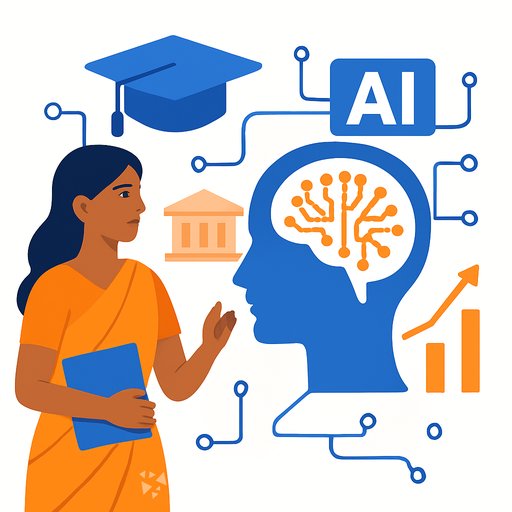AI-Enabled Higher Education: Adapt Now or Fall Behind
Universities run on data-admissions, exams, records, degrees, and reports. AI is now part of that daily workflow. A 2024 Times Higher Education survey reports that nearly 60% of professors use AI tools, and UNESCO notes that AI is changing classroom practice faster than any recent policy shift. The question for India isn't "if," it's "how fast."
NEP 2020 Needs AI-Ready Campuses
NEP 2020 sets bold goals: wider access, stronger research, global collaboration, and world-class standards. Those goals become real only if universities integrate AI into teaching, research, and administration. The institutions that prepare will grow. The rest will slip.
Teaching Is Being Redesigned
AI doesn't replace teachers; it raises the bar for them. Students still need human judgment, context, and mentorship-things algorithms can't provide. Educators shift from "delivering content" to shaping learning experiences.
The biggest move is in assessment. Universities are adopting authentic assessments: oral exams, reflective papers, in-class problem-solving, applied projects, and viva-style defences that test original thinking. This is consistent with NEP 2020's push for competency-based learning.
New roles are emerging on campus: learning designers, curriculum architects, educational technologists, and specialists in AI-integrated pedagogy. These roles will define academic teams over the next decade.
Research Is Being Accelerated
AI cuts research overhead. Literature reviews, trend mapping, citation clustering, translations, and visualisations now take hours, not weeks. As Nature put it, AI is a capable assistant that still requires human oversight.
Collaboration is expanding across fields-computer science, social sciences, environmental science, healthcare-because AI makes cross-domain work more practical. Tools can suggest study designs, draft abstracts, flag statistical errors, and catch conflicting citations. None of this replaces the researcher; it amplifies their capacity.
Universities must set clear guardrails. Train faculty to spot bias, verify AI outputs, and document tool use. With UGC encouraging R&D cells, campuses can use AI to scan funding calls, match them to faculty strengths, and support proposal development-especially for promising researchers who lack writing support.
Administration Is Getting Smarter
AI helps manage the heavy lift of admissions, exams, records, degree audits, and reporting. Evidence from global higher-ed administration shows that automation frees staff from clerical churn so they can spend more time helping students.
That efficiency brings new responsibilities. Universities need data stewards, fairness auditors, and student experience leads who can ensure systems are accurate, equitable, and privacy-safe. Trust is non-negotiable: records must be secure, assessments must be fair, and student data must never be misused.
New Academic Jobs Are Emerging
Three clusters of roles are growing fast. First, teaching innovation: professionals who help faculty blend AI with sound learning design. Second, research enablement: engineers and data specialists who support AI-assisted research workflows. Third, governance: leaders who set policy and ensure responsible AI use.
Faculty roles are evolving too. Educators need skills in AI-informed instruction, validation of AI outputs, and supervision of student use of tools. The universities that invest in these skills will build future-ready teams.
A 90-Day Action Plan for Universities
- Set up a cross-functional AI task force (academics, IT, legal, student services) with a clear mandate and timeline.
- Publish baseline policies: acceptable use, data privacy, model transparency, and assessment integrity.
- Pilot authentic assessments in 3-5 high-enrolment courses; share rubrics and outcomes across departments.
- Launch faculty micro-trainings on prompt design, verification, bias detection, and citation practices.
- Create an approved tool registry, risk tiers, and a simple request process for new tools.
- Stand up an R&D support desk to help with funding scans, proposal drafting, and compliance checks.
- Appoint data stewards; audit admissions, exam, and records workflows for accuracy and fairness.
- Define KPIs: turnaround time for reviews, plagiarism/contract cheating incidents, student satisfaction, and staff hours saved.
Why India Must Move Now
India has shown it can deliver at scale-public digital infrastructure and indigenous telecom successes proved that. With one of the largest university networks and millions of learners, India can integrate AI while preserving the human purpose of education. Move early, and campuses here will attract global students seeking modern learning at a fair cost.
Countries that use AI wisely in higher education will set the pace for the next era. India can lead-if universities act now.
Helpful Resources
Upskill Your Team
If your faculty and staff need structured AI training paths by role, see AI upskilling paths for faculty and staff. For fresh options, browse the latest AI courses.
Your membership also unlocks:






